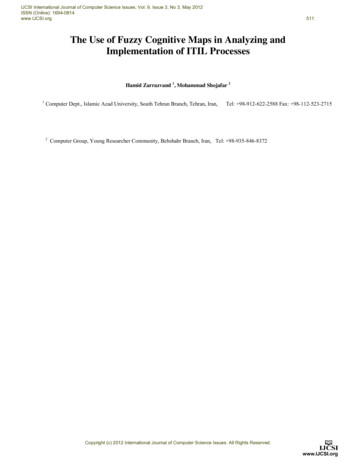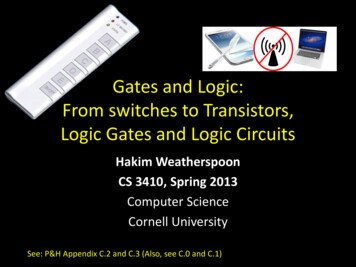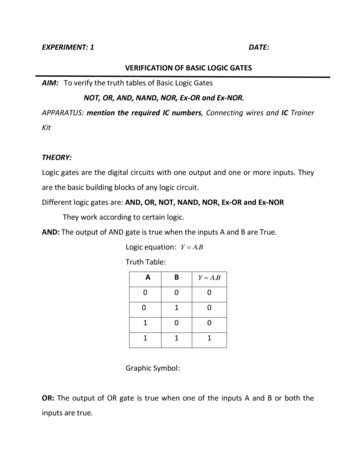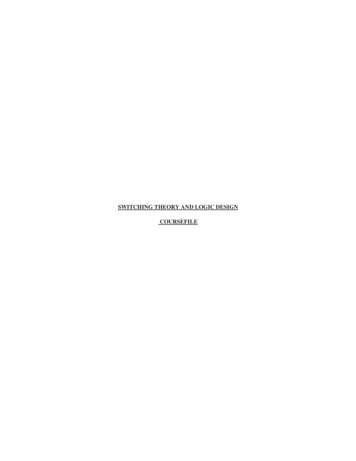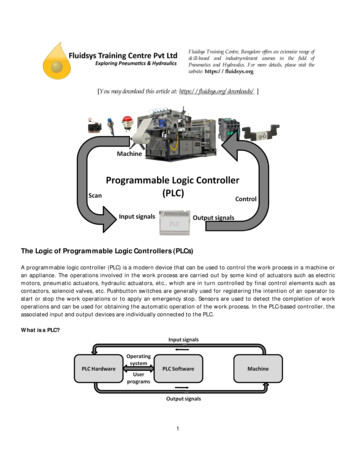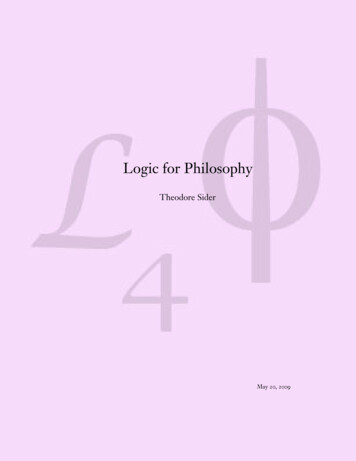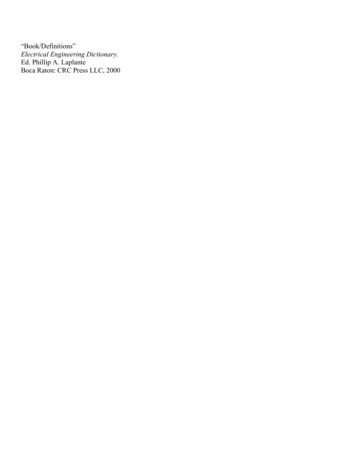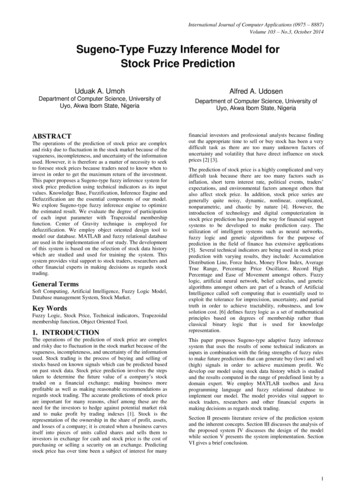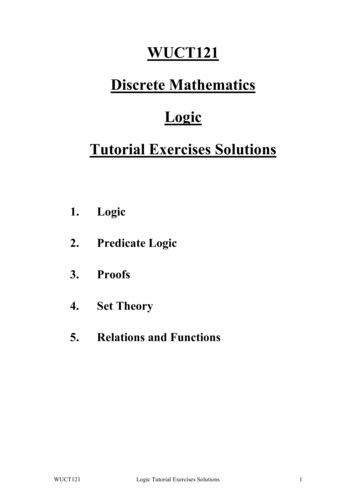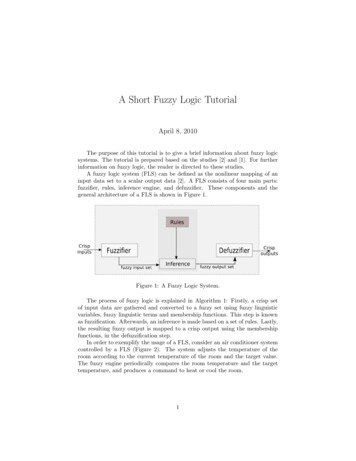
Transcription
A Short Fuzzy Logic TutorialApril 8, 2010The purpose of this tutorial is to give a brief information about fuzzy logicsystems. The tutorial is prepared based on the studies [2] and [1]. For furtherinformation on fuzzy logic, the reader is directed to these studies.A fuzzy logic system (FLS) can be defined as the nonlinear mapping of aninput data set to a scalar output data [2]. A FLS consists of four main parts:fuzzifier, rules, inference engine, and defuzzifier. These components and thegeneral architecture of a FLS is shown in Figure 1.Figure 1: A Fuzzy Logic System.The process of fuzzy logic is explained in Algorithm 1: Firstly, a crisp setof input data are gathered and converted to a fuzzy set using fuzzy linguisticvariables, fuzzy linguistic terms and membership functions. This step is knownas fuzzification. Afterwards, an inference is made based on a set of rules. Lastly,the resulting fuzzy output is mapped to a crisp output using the membershipfunctions, in the defuzzification step.In order to exemplify the usage of a FLS, consider an air conditioner systemcontrolled by a FLS (Figure 2). The system adjusts the temperature of theroom according to the current temperature of the room and the target value.The fuzzy engine periodically compares the room temperature and the targettemperature, and produces a command to heat or cool the room.1
Algorithm 1 Fuzzy logic algorithm1.2.3.4.Define the linguistic variables and terms (initialization)Construct the membership functions (initialization)Construct the rule base (initialization)Convert crisp input data to fuzzy valuesusing the membership functions (fuzzification)5. Evaluate the rules in the rule base (inference)6. Combine the results of each rule (inference)7. Convert the output data to non-fuzzy values (defuzzification)Figure 2: A Simple FLS to Control an Air Conditioner.Linguistic VariablesLinguistic variables are the input or output variables of the system whosevalues are words or sentences from a natural language, instead of numericalvalues. A linguistic variable is generally decomposed into a set of linguisticterms.Example: Consider the air conditioner in Figure 2. Let temperature (t) is thelinguistic variable which represents the temperature of a room. To qualify thetemperature, terms such as “hot” and “cold” are used in real life. These are thelinguistic values of the temperature. Then, T(t) {too-cold, cold, warm, hot,too-hot} can be the set of decompositions for the linguistic variable temperature.Each member of this decomposition is called a linguistic term and can cover aportion of the overall values of the temperature.Membership FunctionsMembership functions are used in the fuzzification and defuzzification stepsof a FLS, to map the non-fuzzy input values to fuzzy linguistic terms and viceversa. A membership function is used to quantify a linguistic term. For instance,in Figure 3, membership functions for the linguistic terms of temperature variable are plotted. Note that, an important characteristic of fuzzy logic is that anumerical value does not have to be fuzzified using only one membership function. In other words, a value can belong to multiple sets at the same time.For example, according to Figure 3, a temperature value can be considered as“cold” and “too-cold” at the same time, with different degree of memberships.2
Figure 3: Membership Functions for T(temperature) {too-cold, cold, warm,hot, too-hot}.There are different forms of membership functions such as triangular, trapezoidal, piecewise linear, Gaussian, or singleton (Figure 4). The most commontypes of membership functions are triangular, trapezoidal, and Gaussian shapes.The type of the membership function can be context dependent and it is generally chosen arbitrarily according to the user experience [2].Figure 4: Different Types of Membership Functions.Fuzzy RulesIn a FLS, a rule base is constructed to control the output variable. A fuzzyrule is a simple IF-THEN rule with a condition and a conclusion. In Table 1,sample fuzzy rules for the air conditioner system in Figure 2 are listed. Table 2shows the matrix representation of the fuzzy rules for the said FLS. Row captionsin the matrix contain the values that current room temperature can take, columncaptions contain the values for target temperature, and each cell is the resultingcommand when the input variables take the values in that row and column. Forinstance, the cell (3, 4) in the matrix can be read as follows: If temperature iscold and target is warm then command is heat.3
Table 1: Sample fuzzy rules for air conditioner system1.2.3.Fuzzy RulesIF (temperature is cold OR too-cold) AND (target is warm) THEN command is heatIF (temperature is hot OR too-hot) AND (target is warm) THEN command is coolIF (temperature is warm) AND (target is warm) THEN command is no-changeTable 2: Fuzzy matrix geFuzzy Set OperationsThe evaluations of the fuzzy rules and the combination of the results of theindividual rules are performed using fuzzy set operations. The operations onfuzzy sets are different than the operations on non-fuzzy sets. Let µA and µB arethe membership functions for fuzzy sets A and B. Table 3 contains possible fuzzyoperations for OR and AND operators on these sets, comparatively. The mostlyused operations for OR and AND operators are max and min, respectively. Forcomplement (NOT) operation, Eq. 1 is used for fuzzy sets.µA (x) 1 µA (x)(1)Table 3: Fuzzy set operationsMAXASUMBSUMOR (Union)M ax{µA (x), µB (x)}µA (x) µB (x) µA (x)µB (x)M in{1, µA (x) µB (x)}MINPRODBDIFAND (intersection)M in{µA (x), µB (x)}µA (x)µB (x)M ax{0, µA (x) µB (x) 1}After evaluating the result of each rule, these results should be combined toobtain a final result. This process is called inference. The results of individualrules can be combined in different ways. Table 4 contains possible accumulationmethods that are used to combine the results of individual rules. The maximumalgorithm is generally used for accumulation.4
Table 4: Accumulation methodsOperationMaximumBounded sumNormalized sumFormulaM ax{µA (x), µB (x)}M in{1, µA (x) µB (x)}µA (x) µB (x)M ax{1,M ax{µA (x0 ),µB (x0 )}}DefuzzificationAfter the inference step, the overall result is a fuzzy value. This result shouldbe defuzzified to obtain a final crisp output. This is the purpose of the defuzzifiercomponent of a FLS. Defuzzification is performed according to the membershipfunction of the output variable. For instance, assume that we have the result inFigure 5 at the end of the inference. In this figure, the shaded areas all belongto the fuzzy result. The purpose is to obtain a crisp value, represented with adot in the figure, from this fuzzy result.Figure 5: Defuzzification step of a FLS.There are different algorithms for defuzzification too. The mostly-used algorithms are listed in Table 5. The meanings of the variables used in Table 5are explained in Teble 6.Table 5: Defuzzification algorithms [1]OperationFormulaRmaxCenter of GravityU u µ(u) duRminmaxCenter of Gravity for SingletonsPp min µ(u) du[ui µi ]Pi 1pLeft Most MaximumRight Most MaximumU inf (u0 ), µ(u0 ) sup(µ(u))U sup(u0 ), µ(u0 ) sup(µ(u))[µi ]i 15
Table 6: The variables in Table 5VariableUupµiminmaxsupinfMeaningresult of defuzzificationoutput variablenumber of singletonsmembership function after accumulationindexlower limit for defuzzificationupper limit for defuzzificationlargest valuesmallest valueReferences[1] Fuzzy control programming. Technical report, International ElectrotechnicalCommision, 1997.[2] J. Mendel. Fuzzy logic systems for engineering: a tutorial. Proceedings ofthe IEEE, 83(3):345–377, Mar 1995.6
A Short Fuzzy Logic Tutorial April 8, 2010 The purpose of this tutorial is to give a brief information about fuzzy logic systems. The tutorial is prepared based on the studies [2] and [1]. For further information on fuzzy logic, the reader is directed to these studies. A fuzzy logic system (FLS) can be de ned as the nonlinear mapping of an


